Study on the Effect of Interfacial Modification on the Properties of Super Standard Mica Sand Cement-Based Materials
Abstract
:1. Introduction
2. Materials and Methods
2.1. Raw Materials
2.2. Preparation of Mortar
2.3. Preparation of Concrete
2.4. Strength Test
2.5. Dry Shrinkage Deformation Test
2.6. Chloride Ion Diffusion Test
2.7. XRD, SEM, and MIP Tests
3. Results and Discussion
3.1. Effect of Mica Content on Mechanical Strength of Mortar and Concrete
3.2. Effect of Interfacial Modifier on Strength of Mortar
3.3. Effect of Curing Method on Strength of Mortar
3.4. Effect of Mineral Admixtures on Compressive Strength of Concrete with Excessive Mica
3.5. Dry Shrinkage Deformation of Concrete
3.6. Chloride Ion Diffusion
3.7. XRD
3.8. MIP
3.9. SEM
3.10. Interface Modification Mechanism
4. Conclusions
- (1)
- The mechanical strength of mortar and concrete decreases with an increase in the mica content in sand, and the strength of cement-based materials linearly decreases with the mica content in sand. When the mica content in sand exceeds 6%, the compressive strength of mortar and concrete decreases by 22.3% and 33.5%, respectively, and the drying shrinkage strain of concrete increases by 25%.
- (2)
- The addition of SCA is an effective way to solve the deterioration of the mortar and concrete containing the mica. Adding the SCA with 50% mica weight, the compressive strength of mortar at 28 d can be increased by 10.9% under natural curing temperature.
- (3)
- Natural curing is beneficial to the interfacial modification of the mica by the SCA. The compressive strength of the mortar mixed with the SCA under natural curing at 28 d is 10.7% higher than that under standard curing.
- (4)
- The coupling of the mineral admixture and SCA can improve the deterioration of mica on the strength of concrete. The compressive strength at 28 d increases by 4.7% when only 20% fly ash is added to the concrete with 4% mica. The compressive strength of concrete at 28 d increases by 7.3% after adding 20% fly ash and 50% SCA of the mica weight.
- (5)
- The higher the content of the mica in sand, the greater the dry shrinkage strain of concrete and the faster the diffusion of chloride ions. The dry shrinkage strain of the mica on concrete and the diffusion of chloride ions can be reduced by adding 50% SCA.
- (6)
- The hydration products are not changed when the interfacial agent is added in the super standard mica sand cement-based materials. The SCA forms a bridge structure between the mica particles and the hydration products, reduces the number of harmful pores in cement-based materials, improves the microstructure of the binding zone around the mica particles, and increases the bonding force in the interface zone around the mica.
Author Contributions
Funding
Data Availability Statement
Conflicts of Interest
References
- Wang, X.; Zhang, W.; Zhang, Y.; Qiao, H.; Xue, C.; Mundia, M.M.; An, B. Research on the green preparation of manufactured sand by tuff produced in Gansu China and its influence on the properties of concrete. Constr. Build. Mater. 2023, 409, 133794. [Google Scholar] [CrossRef]
- Premanand, R.; Sundari, K.T.; Aishwarya, N.; Karthikeyan, B. An experimental analysis on the replacement of fine aggregate by manufacture sand. Mater. Today Proc. 2023; in press. [Google Scholar] [CrossRef]
- Le, N.B.; Toyota, H.; Takada, S. Evaluation of mechanical properties of mica-mixed sand considering inherent anisotropy. Soils Found. 2020, 60, 533–550. [Google Scholar] [CrossRef]
- Zhang, X.; Liu, X.; Gao, H.; Wang, G.; An, R.; Liang, Z. Impact of mica on geotechnical behavior of weathered granitic soil using macro and micro investigations. J. Rock Mech. Geotech. Eng. 2023; in press. [Google Scholar] [CrossRef]
- Xue, H.-L.; Han, C.-Q.; Chen, M.-L.; Fan, G.; Zhou, J.-W. Improving mechanical properties of manufactured sand concrete with high biotite content: Application of magnetic separation process and equipment optimization. Constr. Build. Mater. 2022, 350, 128861. [Google Scholar] [CrossRef]
- Wu, B.; Xiong, Y.M. Influence of sandstone sand manufactured by excavated waste on properties of cement mortar. Case Stud. Constr. Mater. 2024, 20, e02777. [Google Scholar] [CrossRef]
- Leemann, A.; Lothenbach, B.; Münch, B.; Campbell, T.; Dunlop, P. The “mica crisis” in Donegal, Ireland—A case of internal sulfate attack? Cem. Concr. Res. 2023, 168, 107149. [Google Scholar] [CrossRef]
- Brough, C.; Staniforth, B.; Garner, C.; Garside, R.; Colville, R.; Strongman, J.; Fletcher, J. High risk concrete blocks from County Donegal: The geology of defective aggregate and the wider implications. Constr. Build. Mater. 2023, 408, 133404. [Google Scholar] [CrossRef]
- SL/T 352-2020; Test Code for Hydraulic Concrete. China Water and Power Press: Beijing, China, 2020.
- Hoon, R.C.; Sharma, K.R. The selection, processing and specification of aggregates for concrete for large dams; effect of employing micaceous sand as fine aggregate fraction on the properties of cement mortar and concrete. In Proceedings of the 7th ICOLD Congress, Rome, Italy, 26 June–1 July 1961; pp. 363–379. [Google Scholar]
- Dewar, J.D. Effect of Mica in the Fine Aggregate on the Water Requirement and Strength of Concrete; Cement Concrete Association: London, UK, 1963. [Google Scholar]
- James, W. Effect of mica, aggregate coatings, and water-soluble impurities on concrete. Concr. Int. 1990, 12, 54–58. [Google Scholar]
- Wakizaka, Y.; Ichikawa, K.; Nakamura, Y.; Anan, S. Deterioration of concrete due to specific minerals. Environ. Econ. 2001, 2, 331–338. [Google Scholar]
- Structural Materials Research Institute of Water Resources and Hydropower Research Institute. Mass Concrete; China Water Power Press: Beijing, China, 1990. [Google Scholar]
- Li, J.Z.; Ju, G.D. Study on properties of concrete prepared with stone sands of Gushuling in Three Gorges Project. J. Yangtze River Sci. Res. Inst. 2001, 18, 53–56. [Google Scholar]
- Fu, W.R. Research and application of Three Gorges Gushuling gravel sand concrete. Yunnan Water Power 2002, 18, 59–62. [Google Scholar]
- Zhong, Y.H.; Zhou, Z.G.; Ran, J. Effect of Sand with High Mica Content on Frost Resistance of Hydraulic Concrete; Southwest Jiaotong University Press: Chengdu, China, 2006; pp. 168–171. [Google Scholar]
- Zhang, Z.J. Test and study on the mix proportion of the face slab concrete for the facing rockfill dam in the Qiezishan Reservoir. Water Power 2000, 3, 43–46. [Google Scholar]
- Li, X.Y.; Ren, J.J.; Chen, Y.H. Study on performances of concrete with high content of mica in stone powder. J. Hydroelectr. Eng. 2012, 31, 211–215. [Google Scholar]
- Xing, J.Q. Study on the Influence of Free Mica in Artificial Sand Powder on the Properties of Mortar and Concrete; Zhejiang University: Hangzhou, China, 2015. [Google Scholar]
- Mao, Y.L.; Shu, X.; Zhang, Q.Q. Influence of mica fine on rheology of cement mortar. New Build. Mater. 2020, 5, 33–36. [Google Scholar]
- Zhang, M.; Xu, J.; Li, M.; Yuan, X. Influence of Stone Powder Content from Manufactured Sand Concrete on Shrinkage, Cracking, Compressive Strength, and Penetration. Buildings 2023, 13, 1833. [Google Scholar] [CrossRef]
- Li, X.K.; Qin, M.T.; Zhang, Z.Q.; Ming, Y.; Chen, P. Influence of mica content in manufactured sand on concrete performance. J. Guilin Univ. Technol. 2023, 43, 96–99. [Google Scholar]
- Al-Kheetan, M.J.; Jweihan, Y.S.; Rabi, M.; Ghaffar, S.H. Durability Enhancement of Concrete with Recycled Concrete Aggregate: The Role of Nano-ZnO. Buildings 2024, 14, 353. [Google Scholar] [CrossRef]
- He, Z.; Shen, A.; Wang, W.; Zuo, X.; Wu, J. Evaluation and optimization of various treatment methods for enhancing the properties of brick-concrete recycled coarse aggregate. J. Adhes. Sci. Technol. 2022, 10, 1060–1080. [Google Scholar] [CrossRef]
- He, Z.; Shen, A.; Wu, H.; Wang, W.; Wang, L.; Guo, Y. Properties and mechanisms of brick-concrete recycled aggregate strengthened by compound modification treatment. Constr. Build. Mater. 2022, 315, 125678. [Google Scholar] [CrossRef]
- He, Z.; Shen, A.; Guo, Y.; Lyu, Z.; Li, D.; Qin, X.; Zhao, M.; Wang, Z. Cement-based materials modified with superabsorbent polymers: A review. Constr. Build. Mater. 2019, 225, 569–590. [Google Scholar] [CrossRef]
- Hu, K.; Zhou, J.; Han, S.; Chen, Y.; Zhang, W.; Fan, C. Silane coupling agent enhances recycle aggregate/asphalt interfacial properties: An experimental and molecular dynamics study. Mater. Today Commun. 2024, 39, 108681. [Google Scholar] [CrossRef]
- Zhang, M.; Zang, Y.; Shan, L. Enhancing Volumetric Stability of Metakaolin-Based Geopolymer Composites with Organic Modifiers WER and SCA. Buildings 2024, 14, 586. [Google Scholar] [CrossRef]
- Zhang, B.; Li, Q.; Niu, X.; Yang, L.; Hu, Y.; Zhang, J. Influence of a novel hydrophobic agent on freeze–thaw resistance and microstructure of concrete. Constr. Build. Mater. 2021, 269, 121294. [Google Scholar] [CrossRef]
- Hou, C.; Zhang, H. Effect of Silane Coupling Agent Treatment of Aggregates on Mortar Workability, Strength and Interfacial Microscopic Properties. Materials 2023, 16, 7458. [Google Scholar] [CrossRef]
- Liu, J.; Ju, B.; Yin, Q.; Xie, W.; Xiao, H.; Dong, S.; Yang, W. Properties of Concrete Prepared with Silane Coupling Agent-Impregnated Coral Aggregate and Coral Concrete. Materials 2021, 14, 6454. [Google Scholar] [CrossRef]
- Zhu, W.; Xiao, H.; Wang, J.; Li, X. Effect of Different Coupling Agents on Interfacial Properties of Fibre-Reinforced Aluminum Laminates. Materials 2021, 14, 1019. [Google Scholar] [CrossRef]
- Xing, X.; Wei, J.; Xu, W.; Wang, B.; Luo, S.; Yu, Q. Effect of Organic Polymers on Mechanical Property and Toughening Mechanism of Slag Geopolymer Matrix. Polymers 2022, 14, 4214. [Google Scholar] [CrossRef]
- Hodul, J.; Hodná, J.; Mészárosová, L.; Borg, R.P. Experimental Comparison of Efficiency of Water-Soluble and Solvent Hydrophobic Agents for Concrete. Buildings 2022, 12, 1857. [Google Scholar] [CrossRef]
- Zhang, K.; Yin, W.; Chen, X.; Li, H.; Cao, M.; Zhu, S. The Feasibility of Hydroxypropyl Methylcellulose as an Admixture for Porous Vegetarian Concrete Using Coarse Recycled Aggregates. Buildings 2022, 12, 676. [Google Scholar] [CrossRef]
- Liu, H.Q.; Yang, X.Q.; Chen, Y.Z. Experimental study on the effect of mica content in manufactured sand on the performance of cement-based materials. J. N. China Univ. Water Resour. Electr. Power (Nat. Sci. Ed.) 2021, 42, 60–65. [Google Scholar] [CrossRef]
- GB/T 17671-2021; Test Method of Cement Mortar Strength (ISO Method). China Architecture and Building Press: Beijing, China, 2021. (In Chinese)
- GB/T 50081-2019; Concrete Physical and Mechanical Properties. China Architecture and Building Press: Beijing, China, 2019. (In Chinese)
- GB/T 50082-2009; Standard for Test Methods of Long-Term Performance and Durability of Ordinary Concrete. China Architecture and Building Press: Beijing, China, 2009. (In Chinese)
- JTS/T 236-2019; Technical Specification for Test and Inspection of Concrete for Water Transportation Engineering. China Communications Press: Beijing, China, 2019. (In Chinese)
- Li, X.K.; Qin, M.T.; Liao, Q.L.; Zheng, B.; Zheng, G. Effect of mica content in granite manufactured sand on durability of concrete. J. Guilin Univ. Technol. 2023, 43, 1–6. [Google Scholar]
- Feng, Y.; Wang, W.J.; Wang, S.Q. PVA fiber/cement-based interface in silane coupler KH560 reinforced high performance concrete–Experimental and molecular dynamics study. Constr. Build. Mater. 2023, 395, 132184. [Google Scholar] [CrossRef]
- Tran, N.P.; Nguyen, T.N.; Ngo, T.D. The role of organic polymer modifiers in cementitious systems towards durable and resilient infrastructures: A systematic review. Constr. Build. Mater. 2022, 360, 129562. [Google Scholar] [CrossRef]
- Pan, Z.; Chen, J.; Zhan, Q.; Wang, S.; Jin, R.; Shamass, R.; Rossi, F. Mechanical properties of PVC concrete and mortar modified with silane coupling agents. Constr. Build. Mater. 2022, 348, 128574. [Google Scholar] [CrossRef]
- Li, F.; Chen, Q.; Lu, Y.; Zou, Y.; Li, S. Mitigating drying shrinkage and enhancing mechanical strength of fly ash-based geopolymer paste with functionalized MWCNTs grafted with silane coupling agent. Cem. Concr. Compos. 2023, 143, 105250. [Google Scholar] [CrossRef]
- Yang, L.; Pang, Y.; Tang, Q.; Chen, X.; Gao, D.; Li, H.; Wang, H. Effects of the stearic acid modified mica powder on hydrophobic properties and salt freezing resistance of mortar: Experimental study and microscopic mechanism analysis. Constr. Build. Mater. 2024, 416, 135188. [Google Scholar] [CrossRef]
- Wang, W.; Feng, Y.; Li, X.Y. EVA/KH560 synergistically modified recycled concrete mechanical properties-Experiment and molecular dynamics simulations. J. Mol. Graph. Model. 2024, 126, 108641. [Google Scholar] [CrossRef] [PubMed]
- Yu, J. Design and Performance Study of Silane Coupling Agent Modified Rubber Cement-Based Material Based on Molecular Dynamics; Qingdao University of Technology: Qingdao, China, 2022. [Google Scholar] [CrossRef]
- Fan, Y.; Li, Y.; Liu, C.M.; Yang, B.; Liu, X. Preparation and Properties of Fly Ash-Based Geopolymer Inorganic Coatings. Bull. Chin. Creamic Socity 2021, 40, 4020–4029. [Google Scholar] [CrossRef]
- Ren, D.; Wang, Z.; Xu, J.; Luo, W.; Su, S.; Li, F.; Ai, C.; Kong, L. Microscopic mechanisms and chloride resistance performance of silane coupling agent self-assembly on reinforced concrete utilizing X-ray CT technology: A comprehensive investigation. J. Build. Eng. 2023, 80, 107992. [Google Scholar] [CrossRef]
- Feng, B.; Liu, J.; Chen, Y.; Tan, X.; Zhang, M.; Sun, Z. Properties and microstructure of self-waterproof metakaolin geopolymer with silane coupling agents. Constr. Build. Mater. 2022, 342, 128045. [Google Scholar] [CrossRef]
- Zhang, C.; Wang, X.; Hu, Z.; Wu, Q.; Zhu, H.; Lu, J. Long-term performance of silane coupling agent/metakaolin based geopolymer. J. Build. Eng. 2021, 36, 102091. [Google Scholar] [CrossRef]
- Shi, H.S.; Xu, B.W.; Zhou, X.C. Influence of mineral admixtures on compressive strength, gas permeability and carbonation of high performance concrete. Constr. Build. Mater. 2009, 5, 1980–1985. [Google Scholar] [CrossRef]
- Li, F.; Chen, Q.; Lu, Y.; Zou, Y.; Li, S. Dry shrinkage and micro-structure of alkali-activated fly ash/slag pastes incorporated with silane coupling agent modified MWCNTs. Cem. Concr. Res. 2024, 175, 107382. [Google Scholar] [CrossRef]
- Klemczak, B.; Gołaszewski, J.; Smolana, A.; Gołaszewska, M.; Cygan, G. Shrinkage behaviour of self-compacting concrete with a high volume of fly ash and slag experimental tests and analytical assessment. Constr. Build. Mater. 2023, 400, 132608. [Google Scholar] [CrossRef]
- Ying, J.; Deng, C.; Qian, S.; Chen, B. Effect of water-to-binder ratio on chloride ion diffusion in concrete under continuous biaxial compression. Constr. Build. Mater. 2024, 416, 135308. [Google Scholar] [CrossRef]
- Elemam, W.E.; Agwa, I.S.; Tahwia, A.M. Reusing Ceramic Waste as a Fine Aggregate and Supplemental Cementitious Material in the Manufacture of Sustainable Concrete. Buildings 2023, 13, 2726. [Google Scholar] [CrossRef]
- Noushini, A.; Castel, A.; Aldred, J.; Rawal, A. Chloride diffusion resistance and chloride binding capacity of fly ash-based geopolymer concrete. Cem. Concr. Compos. 2020, 105, 103290. [Google Scholar] [CrossRef]
- Al-Awabdeh, F.W.; Al-Kheetan, M.J.; Jweihan, Y.S.; Al-Hamaiedeh, H.; Ghaffar, S.H. Comprehensive investigation of recycled waste glass in concrete using silane treatment for performance improvement. Results Eng. 2022, 16, 100790. [Google Scholar] [CrossRef]
- Zhang, R.; Wang, H.; Ji, J.; Suo, Z.; Ou, Z. Influences of different modification methods on surface activation of waste tire rubber powder applied in cement-based materials. Constr. Build. Mater. 2022, 314 Pt B, 125191. [Google Scholar] [CrossRef]
- Ren, L.; Ma, T.; Bao, S.; Zhang, Y.; Jiao, Z.; Zhang, X. Enhanced flotation performance and adsorption mechanism on (002) crystal plane of fine muscovite powder. Adv. Powder Technol. 2024, 35, 104317. [Google Scholar] [CrossRef]
- Li, P.; Gao, Y.; Xu, T.L.; Guan, Z. Experimental study on Mica Ore from a certain iron Tailings in Liaoning Province. China Non-Met. Miner. Ind. 2021, 3, 53–55. [Google Scholar]
- Feng, Y. Study on Hydration and Hardening Properties of Cement-Based Materials Mixed with Waste Ceramic Powder; Shijiazhuang Tiedao University: Shijiazhuang, China, 2024. [Google Scholar] [CrossRef]
- Liu, J. Fundamental Research on the High Performance Concrete Made by Iron Tailings and Iron Barren Rocks; University of Science and Technology Beijing: Beijing, China, 2015. [Google Scholar]
- Li, C.Z.; Jiang, L.H. Utilization of limestone powder as an activator for early-age strength improvement of slag concrete. Constr. Build. Mater. 2020, 253, V119257. [Google Scholar] [CrossRef]
- Jin, W.; Jiang, L.; Han, L.; Huang, H.; Zhi, F.; Yang, G.; Niu, Y.; Chen, L.; Wang, L.; Chen, Z. Influence of curing temperature on freeze-thaw resistance of limestone powder hydraulic concrete. Case Stud. Constr. Mater. 2022, 17, e01322. [Google Scholar] [CrossRef]
- Zeng, Q.; Li, K.; Fen-Chong, T.; Dangla, P. Pore structure characterization of cement pastes blended with high-volume fly-ash. Cem. Concr. Res. 2012, 1, 194–204. [Google Scholar] [CrossRef]
- Wang, Z.; Yu, M.; Sun, Z.; Zou, W.; Sun, D.; Zhao, S.; Song, L.; Liu, W.; Liu, F. Enhanced interfacial bonding strength of superhydrophobic wood through chemical etching and silane coupling agent treatment. Constr. Build. Mater. 2024, 411, 134825. [Google Scholar] [CrossRef]
- Liu, T.; Wei, H.; Zhou, A.; Zou, D.; Jian, H. Multiscale investigation on tensile properties of ultra-high performance concrete with silane coupling agent modified steel fibers. Cem. Concr. Compos. 2020, 111, 103638. [Google Scholar] [CrossRef]
- Feng, Y.S. Study on Properties of Kevlar Fiber-Cement Based Material Modified by Silane Coupling Agent; Beijing University of Civil Engineering and Architecture: Beijing, China, 2023. [Google Scholar] [CrossRef]
- Wang, E.C.; Yu, L.H.; Jiang, X.P.; Wang, Y. Effect of recycled coarse aggregate pretreated with chemical solutions on modification of recycled concrete. Bull. Chin. Creamic Socity 2022, 41, 4310. [Google Scholar] [CrossRef]
- Sun, J.S.; Song, Z.P.; Yu, K.Y.; Zhang, H.F. Study of reinforcement of recycle aggregate and properties of recycled concrete. Concrete 2023, 8, 95–99. [Google Scholar]
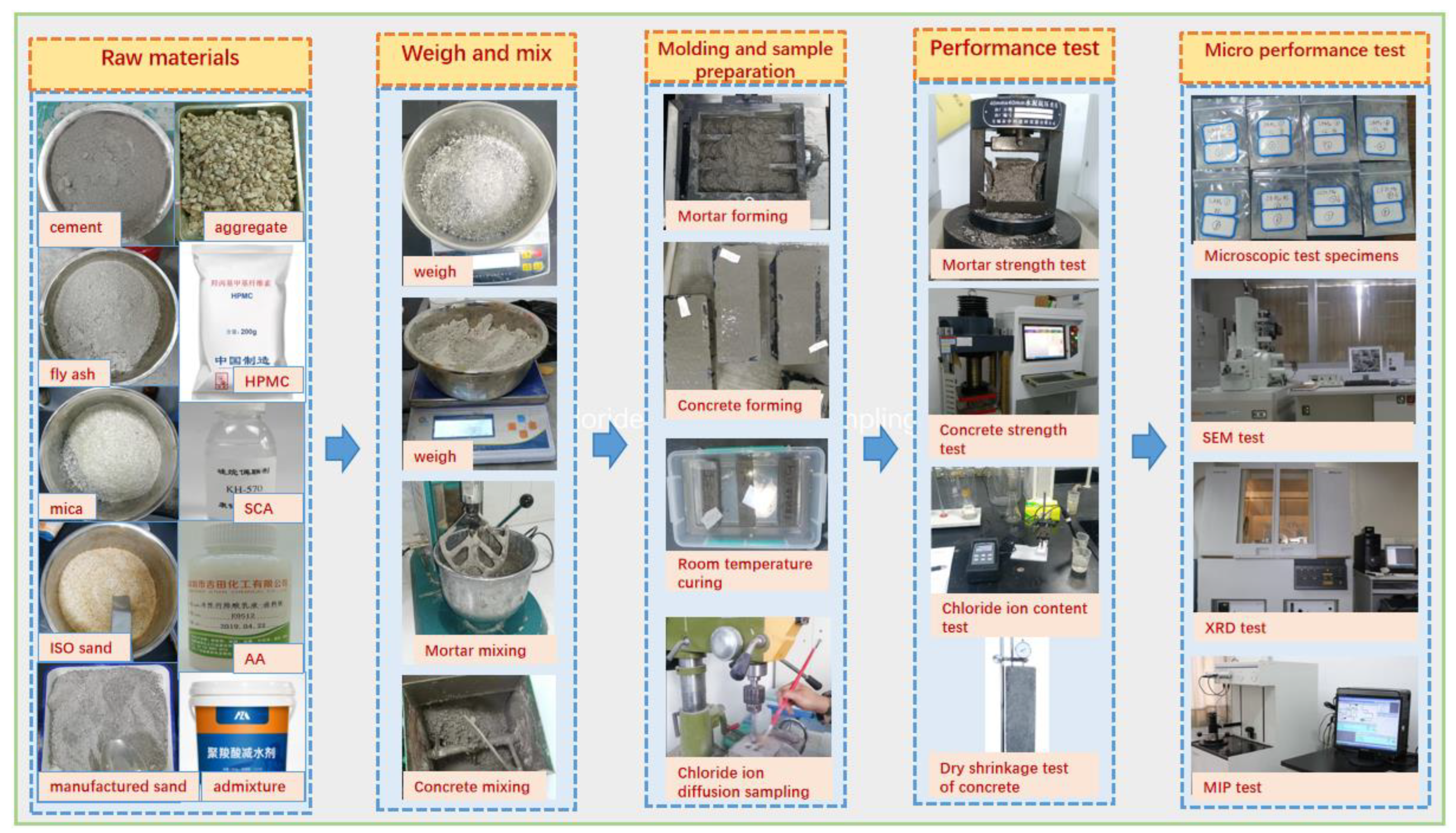

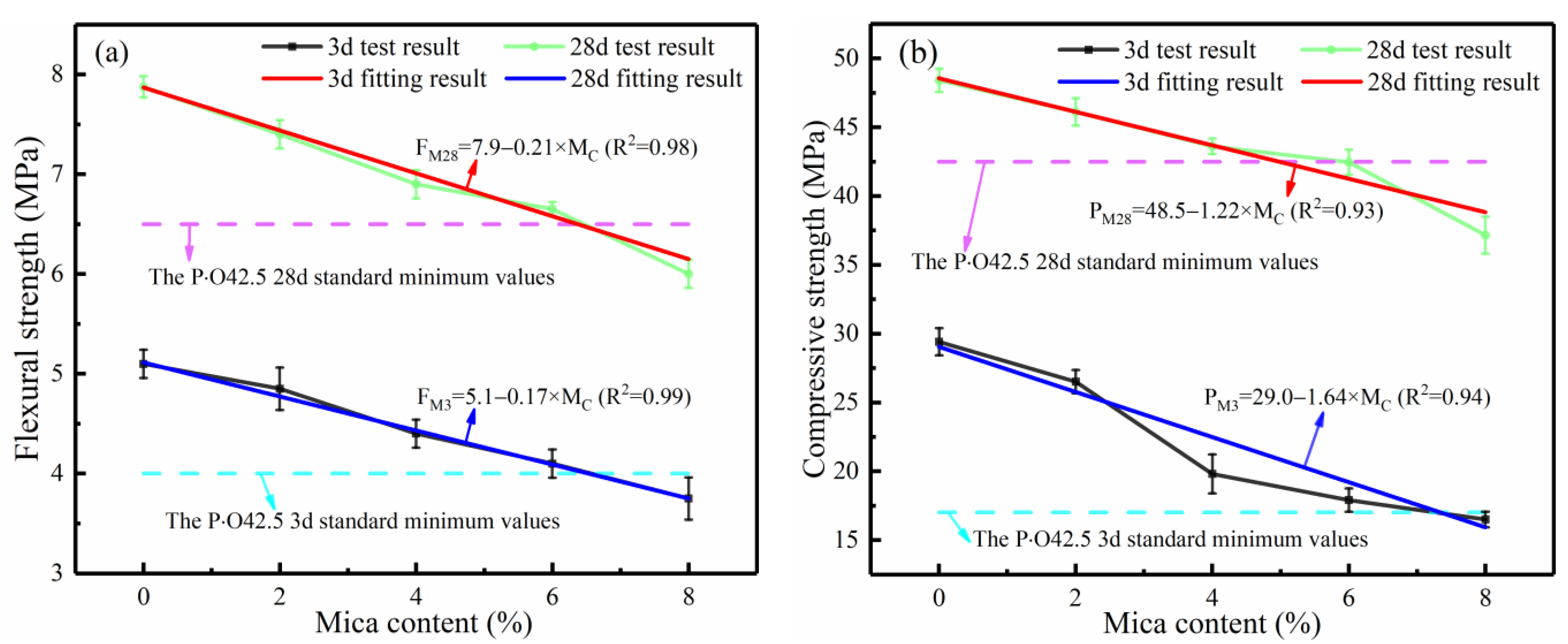


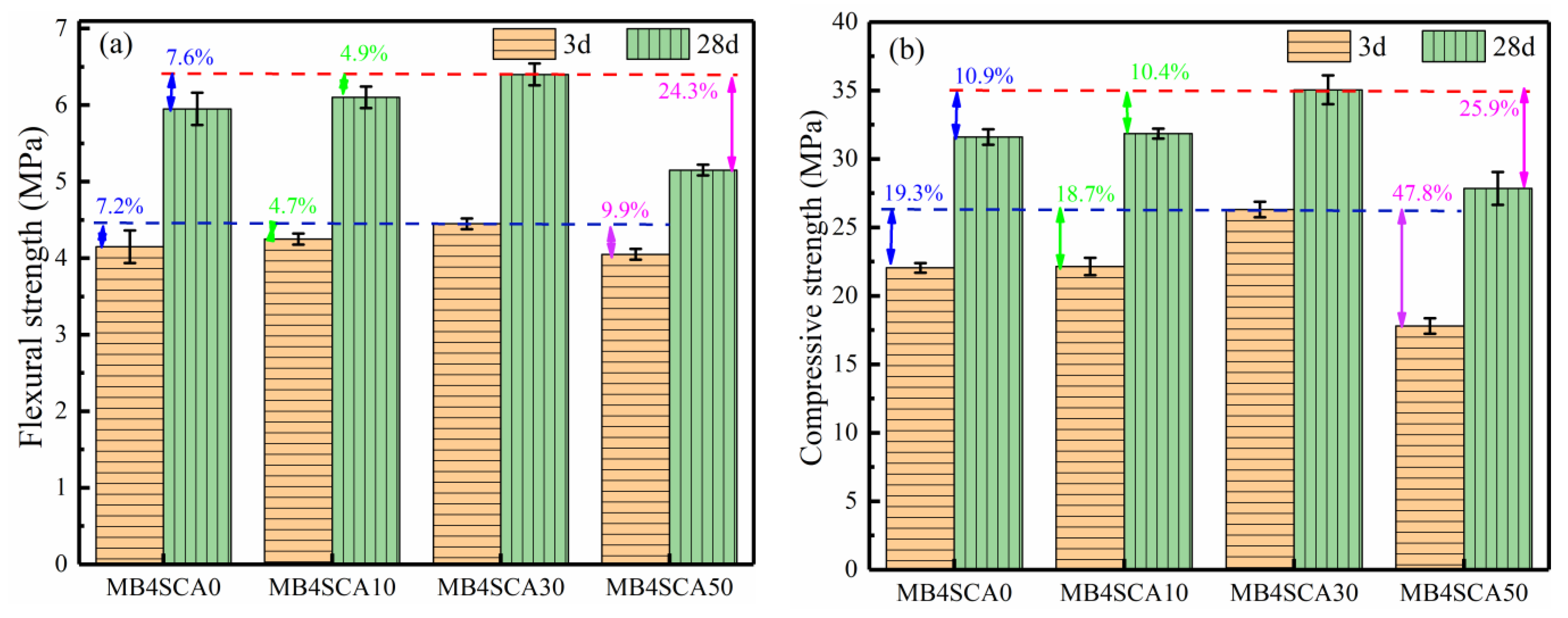
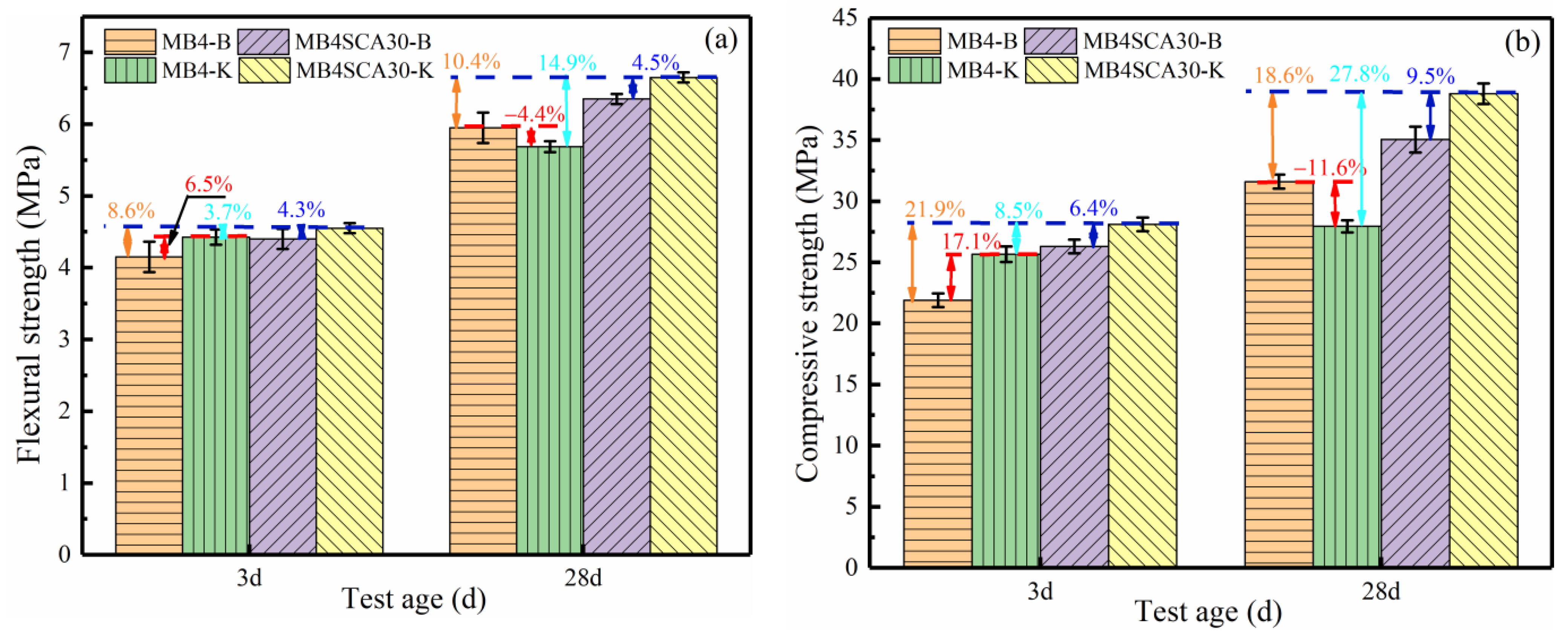
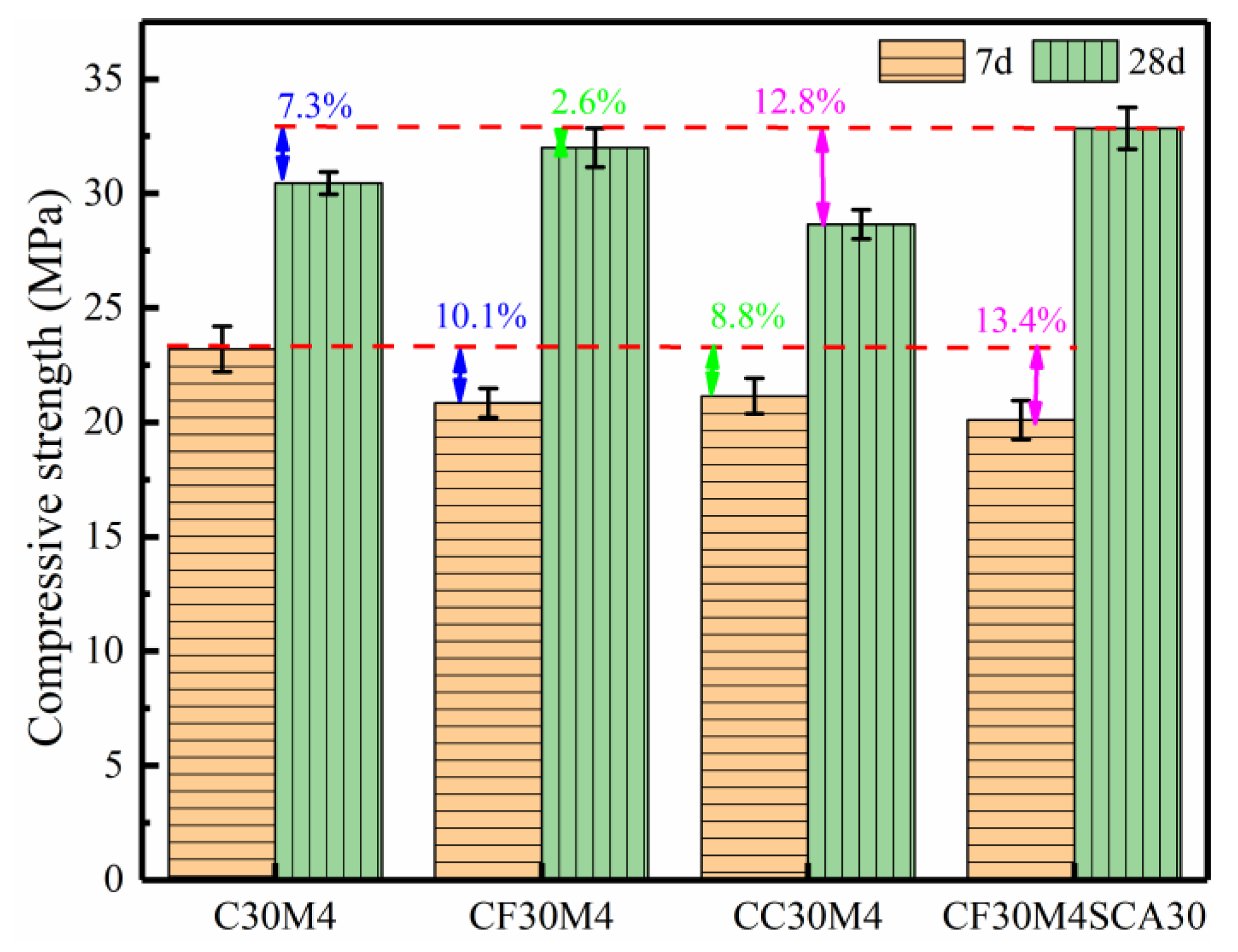

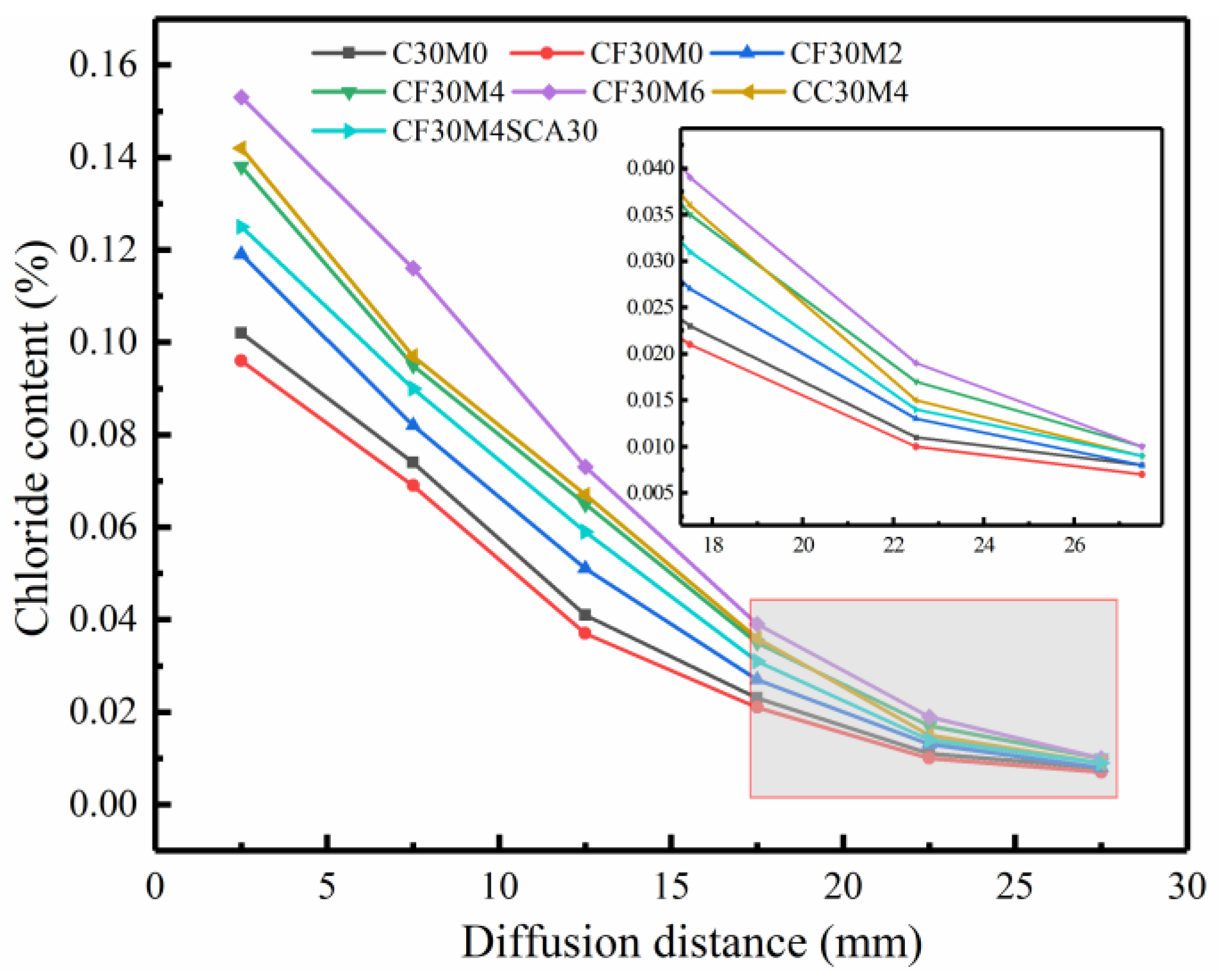
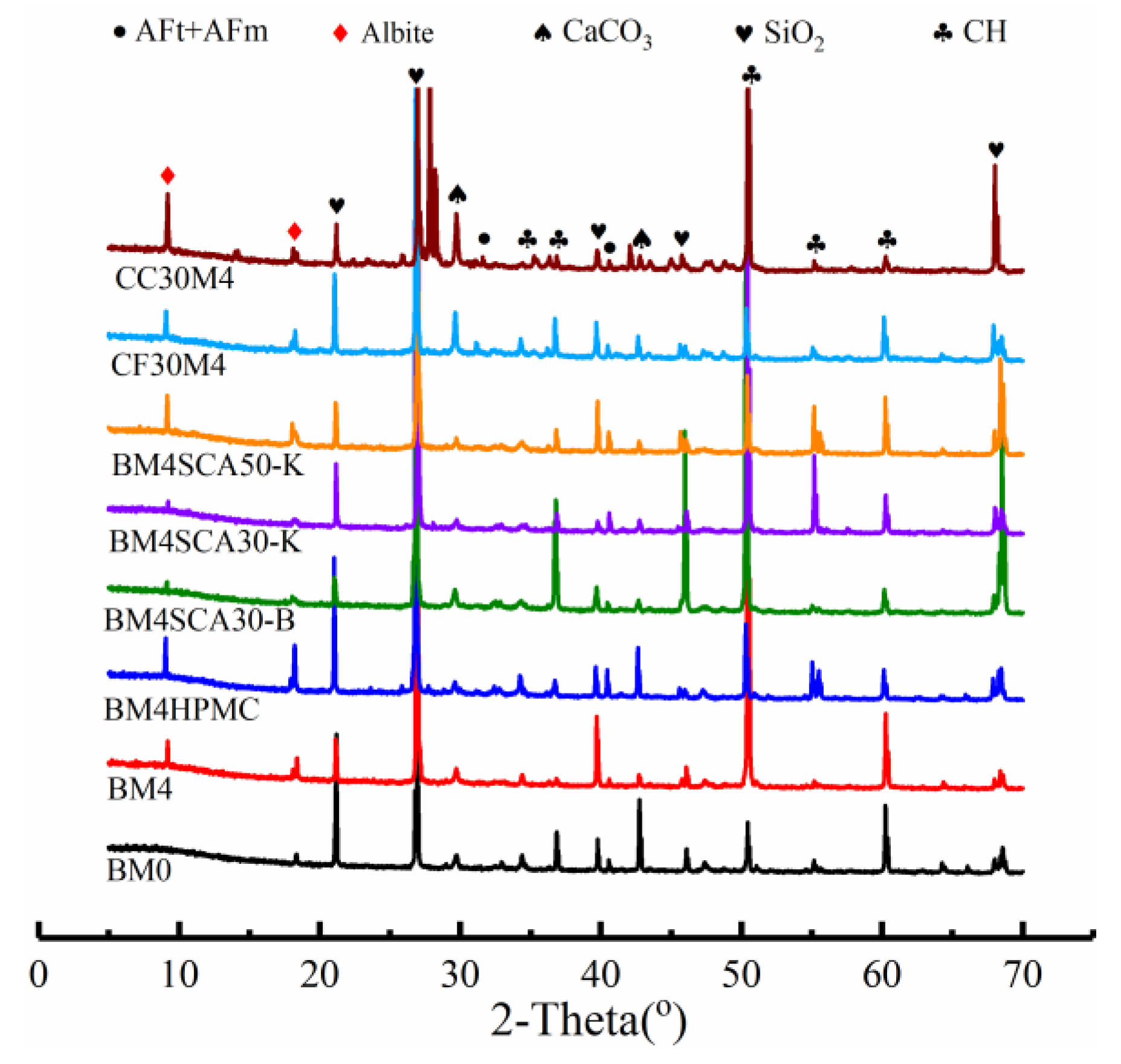

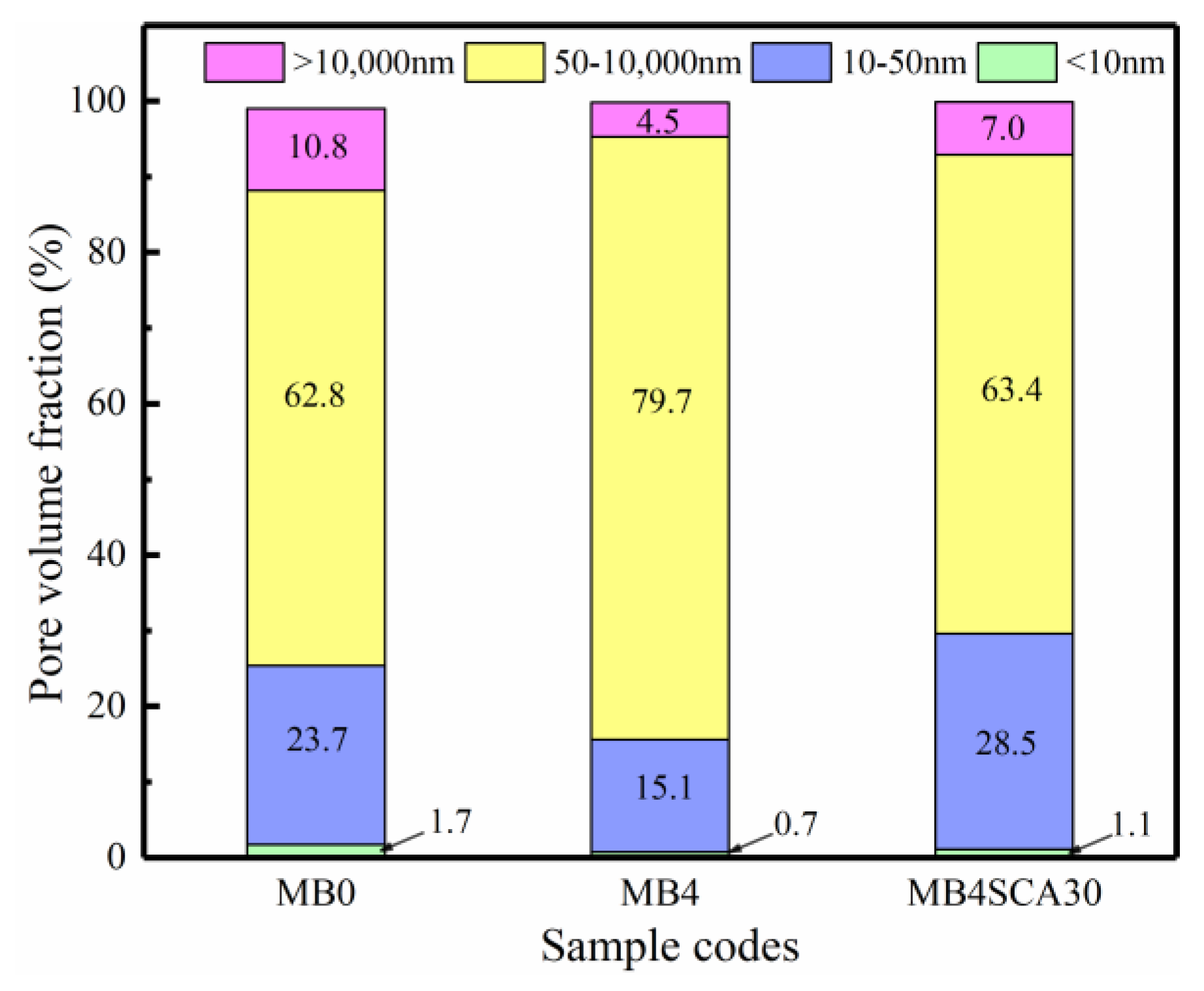
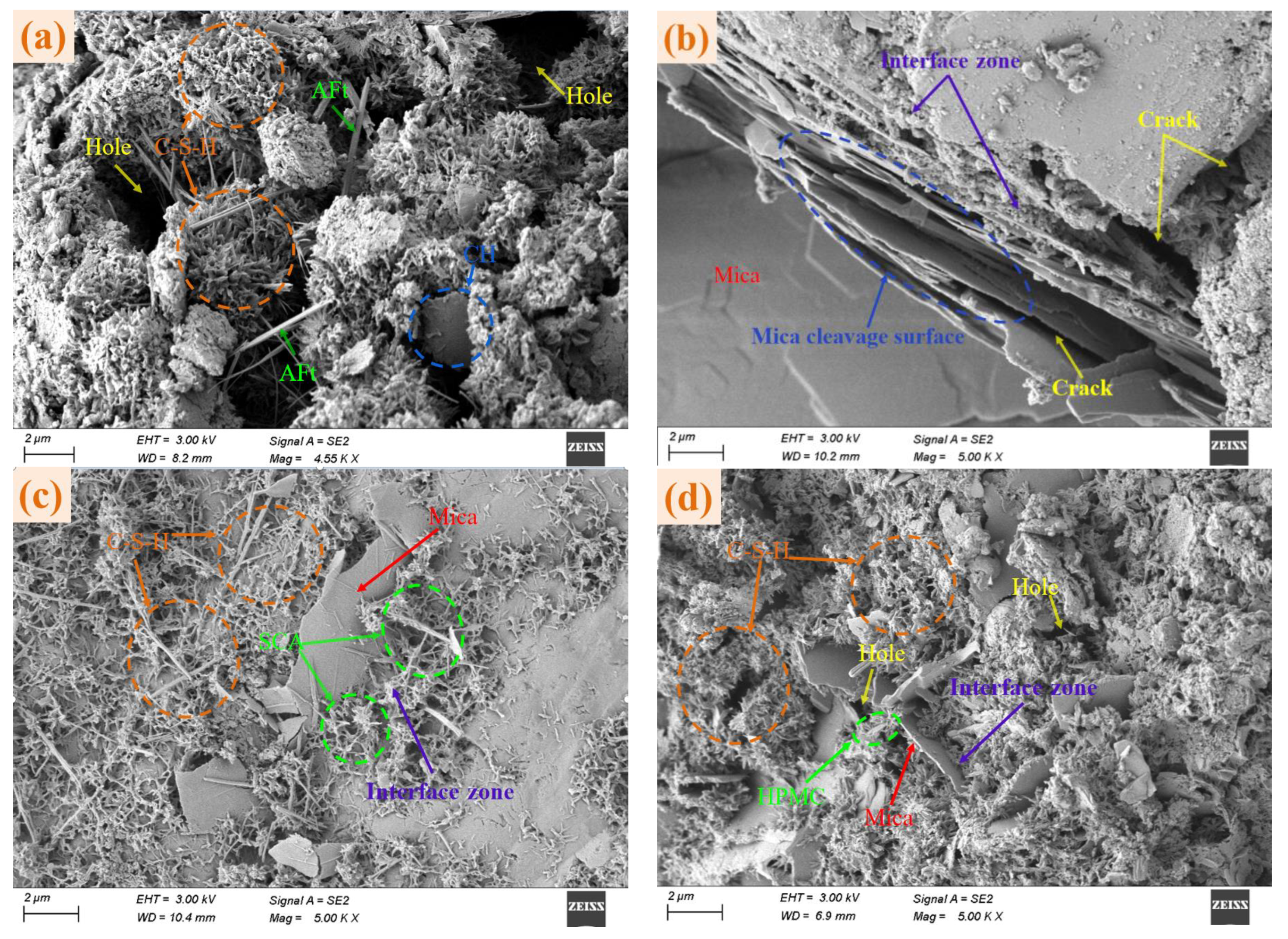

| Specific Surface Area (m2/kg) | Setting Time (min) | Compressive Strength (MPa) | Flexural Strength (MPa) | |||
|---|---|---|---|---|---|---|
| Initial Set | Final Set | 3 d | 28 d | 3 d | 28 d | |
| 345 | 165 | 240 | 27.3 | 46.8 | 4.2 | 7.3 |
| Species | SiO2 | Al2O3 | Fe2O3 | CaO | MgO | SO3 | Na2O | K2O | Loss |
|---|---|---|---|---|---|---|---|---|---|
| Cement | 23.15 | 7.24 | 3.31 | 58.23 | 3.06 | 2.63 | 0.55 | 0.91 | 0.88 |
| Fly ash | 55.14 | 26.76 | 6.91 | 4.93 | 1.41 | 0.71 | 0.68 | 1.20 | 2.09 |
| Ceramic powder | 71.49 | 17.22 | 0.75 | 2.24 | 1.54 | 0.29 | 2.18 | 0.98 | 2.58 |
| Sieve diameter (mm) | ≤0.3 | 0.3~0.5 | 0.5~5 | ≥5.0 |
| Sieve residue (%) | 6.5 | 78.4 | 9.1 | 6.0 |
| Specimens | Cement (g) | ISO Sand (g) | Mica (g) | Water (g) | Admixture (g) | Interfacial Agent (g) |
|---|---|---|---|---|---|---|
| BM0 | 450 | 1350 | 0 | 225 | 0 | 0 |
| BM2 | 450 | 1320 | 30 | 222.5 | 2.5 | 0 |
| BM4 | 450 | 1290 | 60 | 220 | 5 | 0 |
| BM4SCA10 | 450 | 1290 | 60 | 210 | 5 | 10 (16.7%) |
| BM4SCA30 | 450 | 1290 | 60 | 190 | 5 | 30 (50%) |
| BM4SCA50 | 450 | 1290 | 60 | 170 | 5 | 50 (83.3%) |
| BM4AA | 450 | 1290 | 60 | 215 | 5 | 10 |
| BM4HPMC | 450 | 1290 | 60 | 225 | 5 | 5 |
| BM6 | 450 | 1260 | 90 | 217.5 | 7.5 | 0 |
| BM8 | 450 | 1230 | 120 | 215 | 10 | 0 |
| Specimens | Cement (kg) | Mineral Admixture (kg) | Water (kg) | Sand (kg) | Mica (%) | Gravel (kg) | Admixture (g) | Interfacial Agent (g) |
|---|---|---|---|---|---|---|---|---|
| C30M0 | 15 | 0 | 6.3 | 28.5 | 0 | 46.5 | 150 | 0 |
| CF30M0 | 12 | 3 | 6.3 | 28.5 | 0 | 46.5 | 150 | 0 |
| CF30M2 | 12 | 3 | 6.3 | 28.5 | 2 | 46.5 | 150 | 0 |
| CF30M4 | 12 | 3 | 6.3 | 28.5 | 4 | 46.5 | 150 | 0 |
| CC30M4 | 12 | 3 | 6.3 | 28.5 | 4 | 46.5 | 150 | 0 |
| CF30M4SCA30 | 12 | 3 | 6.3 | 28.5 | 4 | 46.5 | 150 | 74.2 |
| CF30M6 | 12 | 3 | 6.3 | 28.5 | 6 | 46.5 | 150 | 0 |
| CF30M8 | 12 | 3 | 6.3 | 28.5 | 8 | 46.5 | 175 | 0 |
Disclaimer/Publisher’s Note: The statements, opinions and data contained in all publications are solely those of the individual author(s) and contributor(s) and not of MDPI and/or the editor(s). MDPI and/or the editor(s) disclaim responsibility for any injury to people or property resulting from any ideas, methods, instructions or products referred to in the content. |
© 2024 by the authors. Licensee MDPI, Basel, Switzerland. This article is an open access article distributed under the terms and conditions of the Creative Commons Attribution (CC BY) license (https://creativecommons.org/licenses/by/4.0/).
Share and Cite
Liu, H.; Yang, X.; Jiang, L.; Li, K.; Wang, L.; Jin, W. Study on the Effect of Interfacial Modification on the Properties of Super Standard Mica Sand Cement-Based Materials. Buildings 2024, 14, 1665. https://doi.org/10.3390/buildings14061665
Liu H, Yang X, Jiang L, Li K, Wang L, Jin W. Study on the Effect of Interfacial Modification on the Properties of Super Standard Mica Sand Cement-Based Materials. Buildings. 2024; 14(6):1665. https://doi.org/10.3390/buildings14061665
Chicago/Turabian StyleLiu, Huanqiang, Xueqing Yang, Linhua Jiang, Keliang Li, Limei Wang, and Weizhun Jin. 2024. "Study on the Effect of Interfacial Modification on the Properties of Super Standard Mica Sand Cement-Based Materials" Buildings 14, no. 6: 1665. https://doi.org/10.3390/buildings14061665





